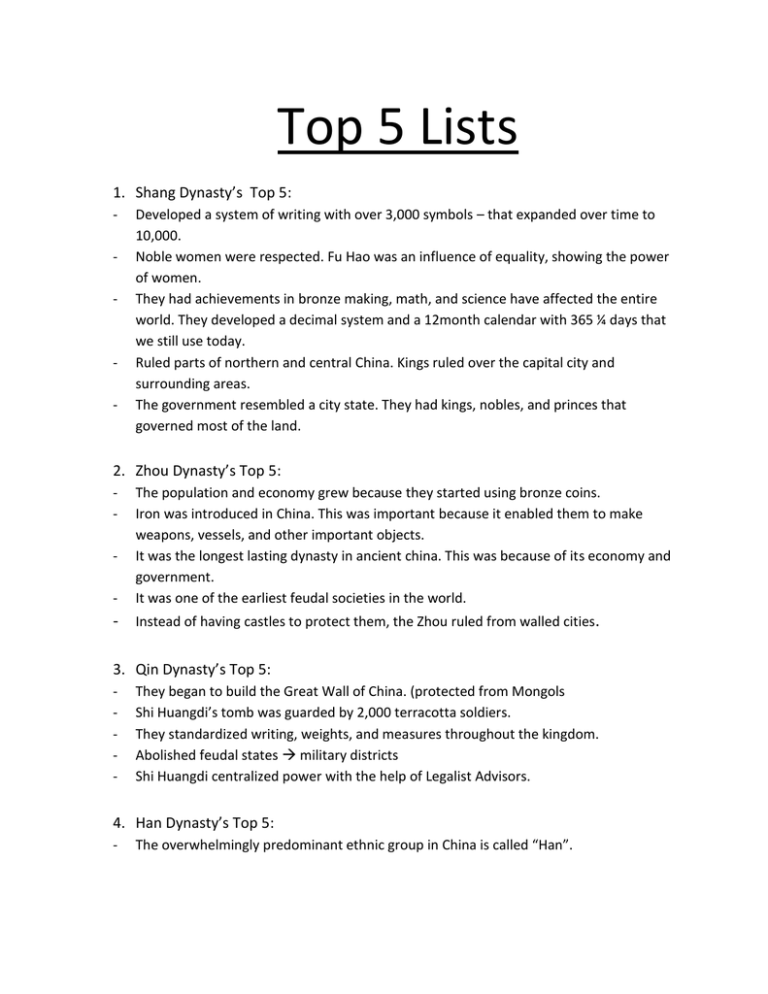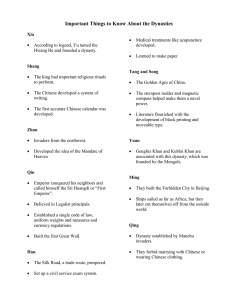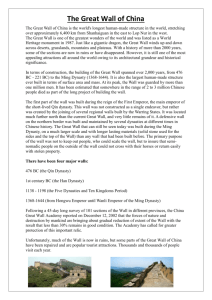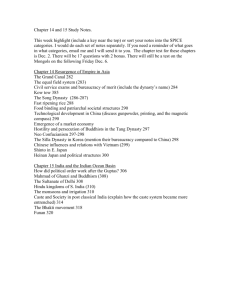Top 5 Lists 1. Shang Dynasty’s Top 5:
advertisement

Top 5 Lists 1. Shang Dynasty’s Top 5: - - Developed a system of writing with over 3,000 symbols – that expanded over time to 10,000. Noble women were respected. Fu Hao was an influence of equality, showing the power of women. They had achievements in bronze making, math, and science have affected the entire world. They developed a decimal system and a 12month calendar with 365 ¼ days that we still use today. Ruled parts of northern and central China. Kings ruled over the capital city and surrounding areas. The government resembled a city state. They had kings, nobles, and princes that governed most of the land. 2. Zhou Dynasty’s Top 5: - The population and economy grew because they started using bronze coins. Iron was introduced in China. This was important because it enabled them to make weapons, vessels, and other important objects. It was the longest lasting dynasty in ancient china. This was because of its economy and government. It was one of the earliest feudal societies in the world. - Instead of having castles to protect them, the Zhou ruled from walled cities. 3. Qin Dynasty’s Top 5: - They began to build the Great Wall of China. (protected from Mongols Shi Huangdi’s tomb was guarded by 2,000 terracotta soldiers. They standardized writing, weights, and measures throughout the kingdom. Abolished feudal states military districts Shi Huangdi centralized power with the help of Legalist Advisors. 4. Han Dynasty’s Top 5: - The overwhelmingly predominant ethnic group in China is called “Han”. - - The origins of the Silk Road were created. It was a very large trading route, connecting everywhere from China to Rome. Silk, furs, figs, grapes, and walnuts were traded along this route. (This spread cultural diffusion) The civil service exam had an enormous impact on China for 2,000 years. It allowed those who were well educated to become government officials. There were many advances in art and science, but most importantly they created durable paper out of wood pulp. Emperor Wudi set up a government monopoly of iron and salt. 5. Tang Dynasty’s Top 5: - - It is ranked as the classical period of Chinese art and literature. Set high standards to which later poets, painters, and sculptors aspired too. A large population (100,000,000 people) accompanied by an accurate census which allowed taxation throughout China. Empress Wu, first and only women to take the title of Emperor. Invented gun powder, which will eventually be used for fireworks and guns. Contributed to the development of astronomy and medicine. They also had the earliest form of the printing press. A system of canals encouraged internal trade and transportation. These canals allowed the south to send crops to the capital in the north. 6. Song Dynasty’s Top 5: - A Golden Age of China that lasted for 319 years. (960-1276) The high point of Chinese innovations, science, and technology. They invented paddle wheel boats and paper money. Also made advances in gun powder. Population increased during the Song Dynasty. Foot binding emerged during this Dynasty. Chinese women’s feet were bound to make them smaller. 7. Yuan Dynasty’s Top 5: - The empire expanded over two continents. Many consecutive rulers/ emperors brought peace to all of Asia. Peace was brought through economic growth and respect for other religions. Marco Polo visited China during this time and described how rich it was. His description of the beauty and riches of China were the driving force to European interest in China. They brought windmills and gunpowder to Europe. They brought the invention of paper to the Middle East. - They had a disciplined mobile army. 8. Ming Dynasty’s Top 5: - - - Ming means brilliant or right. Therefore this was the era of improvement of art, government, and culture. Architecture produced and created the Forbidden City, which is today’s capital of China. Emperor Zheng He was a great navigator in Chinese history. He expanded the Ming Dynasty throughout the South Pacific, Taiwan, Persian Gulf, and the Indian Ocean. They also reached the Eastern bank of Africa. They prayed to their ancestors. They also practiced Buddhism and Taoism. Christianity existed there too but it wasn’t popular. They also established a code where they treated peasants as free citizens instead of animals. Chinese culture embraced art more during this time. Painting and calligraphy spread. Calligraphy was designed and used on lacquer ware. (decorative pieces of wood)





